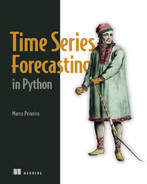Part 2. Forecasting with statistical models
In this part of the book, we’ll explore statistical models for time series forecasting. When performing statistical modeling, we need to perform hypothesis testing, study our data carefully to extract its properties, and find the best model for our data.
By the end of this part, you will have a robust framework for modeling any type of time series using statistical models. You will develop MA(q) models, AR(p) models, ARMA(p,q) models, ARIMA(p,d,q) models for non-stationary time series, SARIMA(p,d,q)(P,D,Q)m for seasonal time series, and SARIMAX models to include external variables in your forecast. We’ll also cover the VAR(p) model for predicting many time series at once. We’ll conclude this part of the book with a capstone project, so that you’ll get to apply what you’ve learned on your own.
There are, of course, many other statistical models for time series forecasting. For example, exponential smoothing basically takes a weighted average of past values to predict future values. The general idea behind exponential smoothing is that past values are less important than more recent values when predicting the future, so they are assigned a smaller weight. This model can then be extended to include trend and seasonal components. There are also statistical approaches to modeling time series with different seasonal periods, such as the BATS and TBATS models.
To keep this section manageable, we won’t address those models, but they are implemented in the statsmodels library, which we will use extensively.
